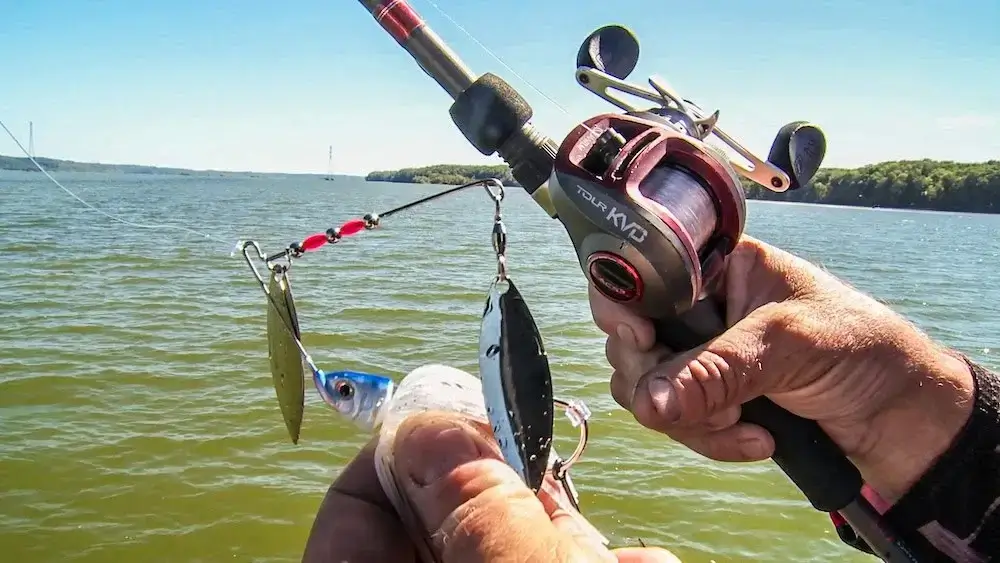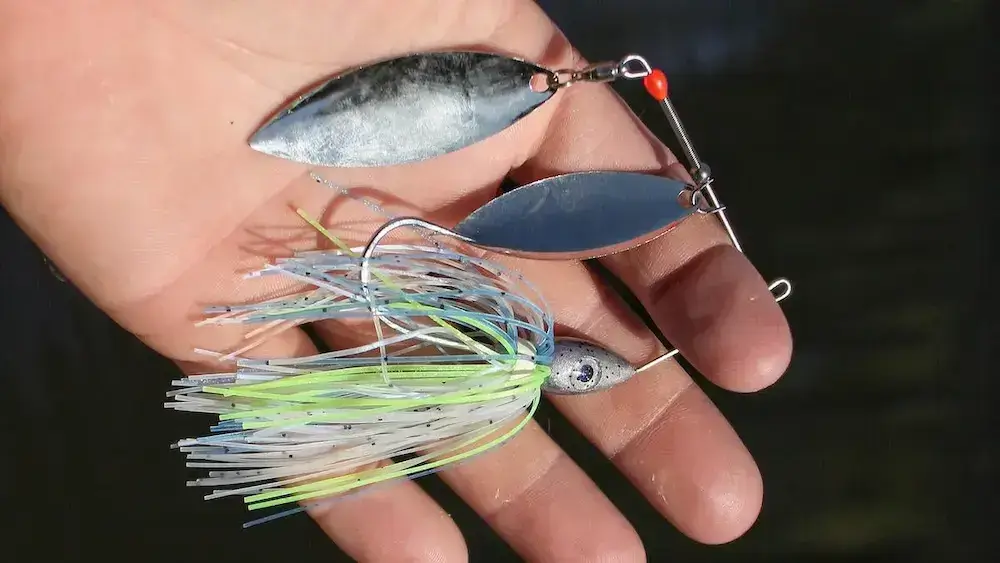Fishing with spinnerbaits can be fun, but it’s important to use the right line for the job. If you’re not using the right line, you won’t be able to maximize your fishing experience.
This blog post will talk about what line is best for spinnerbaits and how to use it correctly. We’ll also discuss some of the benefits of using spinnerbaits and provide some tips on catching more fish.
What Spinnerbaits Are and How They Work

A spinnerbait is a fishing lure consisting of a metal shaft with a spinning blade attached. The blades spin around the shaft, creating what is known as a “rotating action” that attracts fish.
Spinnerbaits are often used to target bass, but they can be effective for other types of fish as well.
There are two main types of spinnerbaits: inline and offset. Inline spinnerbaits have the blades aligned with the shaft, while offset spinnerbaits have the blades offset.
Spinnerbaits can be made with various materials, including metal, plastic, and wood. The size of the spinner bait will also vary depending on the type of fish you’re trying to catch.
Spinnerbaits are typically used with a fishing rod and reel but can also be fished with fly fishing gear. When choosing a spinner bait, it’s important to consider the size, weight, and blade type that will be most effective for the fish you’re targeting.
What Line for Spinnerbaits
One of the most popular questions is, “What line should I use for spinnerbaits?” Unfortunately, the answer to this question isn’t as easy as it seems. To determine the best line for spinnerbaits, you need to consider a few factors.
The first factor to consider when choosing a line for spinnerbaits is water clarity. If you’re fishing in clear water, you’ll want to use a less visible line to the fish.
You can get away with using a more visible line in the stained or muddy water because the fish will be less likely to see it.
The second factor to consider is the type of spinnerbait you’re using. If you’re using a smaller spinnerbait, you’ll want to use a lighter line. If you’re using a larger spinnerbait, you can use a heavier line.
The third factor to consider is the type of fish you’re targeting. If you’re targeting smaller fish, you’ll want to use a lighter line. If you’re targeting larger fish, you can use a heavier line.
Now that you know the three factors to consider when choosing a line for spinnerbaits let’s look at some of the available types of lines.
The most common type of line used for spinnerbaits is fluorocarbon. Fluorocarbon is a great all-around line because it’s strong, abrasion-resistant, and has low stretch.
Another type of line that can be used for spinnerbaits is monofilament. Monofilament is a good choice for anglers fishing in clear water because it’s less visible to fish.
How to Determine Which Type of Line Is Best for You

A fishing line is one of the most important components of your fishing gear. The wrong line can ruin your chances of landing a fish, while the right type can give you an edge.
But with so many different types and brands of fishing line on the market, how do you know which one is right for you?
There are three main types of fishing lines: monofilament, fluorocarbon, and braided. Each type has its advantages and disadvantages.
The monofilament fishing line is made from a single strand of nylon. It is strong and flexible, making it a good choice for beginners.
However, the monofilament line can stretch, making it less sensitive to bites. It is also more likely to break when exposed to sunlight or chemicals.
The fluorocarbon fishing line is made from a fluoropolymer, such as a polyvinylidene fluoride. It is strong and abrasion-resistant, making it a good choice for fishing in heavy cover. However, the fluorocarbon line is more expensive than monofilament and can be difficult to knot.
A braided fishing line is made from multiple strands of material, such as nylon or polyester. It is strong and has little stretch, making it a good choice for experienced anglers. However, the braided line can be difficult to handle and knot.
The fishing line you choose should be based on the type of fishing you plan to strands of material, such as nylon or polyester.
It is strong and has little stretch, making it a good choice for experienced anglers. However, the braided line can be difficult to handle and knot.
Tips on Casting Spinnerbaits
One of the great things about spinnerbaits is that they can be fished in various ways, making them one of the most versatile lures in your tackle box.
But no matter how you fish them, the key to success is getting your spinnerbait down deep where the fish are holding. So here are some tips on casting spinnerbaits to maximize your fishing.
One of the most important things to know when casting spinnerbaits is that they are weighted lures, which will sink quickly if you don’t put enough speed on your retrieve.
This is why it’s important to use a baitcasting reel when fishing with spinnerbaits. In addition, baitcasting reels have brakes that allow you to control the speed of your lure, which is key when casting spinnerbaits.
Another important tip is to use a lighter line when fishing with spinnerbaits. Because they are weighted lures, they will put a lot of strain on your line if you use a heavy line.
This can cause your line to break or snap your rod in half. A good rule of thumb is to use a lighter line than you would normally use for the size of fish you’re targeting.
Finally, when casting spinnerbaits, be sure to use a leader. Leaders are important because they help prevent your line from breaking on the sharp blades of the spinnerbait. A good rule of thumb is to use a leader about twice the length of your rod.
By following these tips, you can be sure to get your spinnerbait down deep where the fish are holding. And with a little practice, you’ll be casting like a pro in no time.
Spinnerbait Fishing Techniques
There are a few different ways to fish with spinnerbaits, and the technique you use will largely depend on the type of fish you’re targeting.
For example, if you’re after bass, you’ll want to use a different technique than if you’re after trout. So here are a few of the most popular spinnerbait fishing techniques:
Fishing with spinnerbaits is a great way to catch a variety of fish. Whether you’re after bass, trout, or another type of fish, a spinnerbait technique will suit your needs. Here are a few of the most popular methods:
- Slow rolling: Slow rolling is a great technique for fishing in clear water or when the fish are finicky. Cast your spinnerbait out and let it sink to the bottom to slow roll. Then, reel it in slowly, keeping your rod tip low to the water. This will give the spinnerbait a chance to swim close to the bottom, where the fish are often feeding.
- Burning: Burning is a great way to quickly cover a lot of water and trigger strikes from aggressive fish. To burn, cast your spinner bait out and reel it in as fast as possible. Keep your rod tip up so the spinnerbait stays close to the surface. This technique is often used when fishing in muddy or stained water, as the fast-moving bait will create a disturbance that will attract the fish.
- Pitching: Pitching is a great technique for fishing around covers, such as docks, logs, and brush piles. To pitch, cast your spinner bait out and let it sink to the bottom. Then, reel in the slack and quickly snap your rod tip up, so the spinner bait pops up over the cover. This will often trigger strikes from fish that are hiding in the cover.
- Flipping: Flipping is a great way to fish around heavy covers, such as thick brush or logs. Cast your spinner bait out and let it sink to the bottom. Then, reel in the slack and quickly flip your wrist so the spinnerbait flips over the cover. This will often trigger strikes from fish that are hiding in the cover.
There you have it! These are just a few of the most popular spinnerbait fishing techniques. Experiment with different techniques and see what works best for you.
Conclusion
While there’s no one-size-fits-all answer to what line to use for spinnerbaits, we hope that this article has helped you understand the different factors to consider and how they can affect your fishing.
With a little trial and error, you should be able to find the perfect line for your spinnerbaits and maximize your fishing success.

